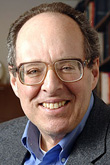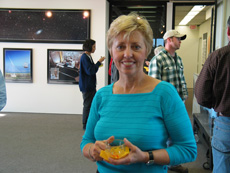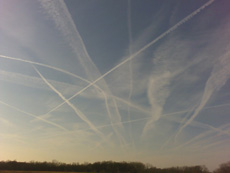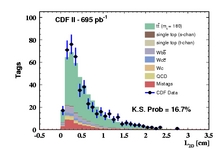|
Thurs., January 4
1:00 p.m. ALCPG ILC Physics and Detector Seminar -
West Wing (WH-10NW)
Speaker: D. Wright, Stanford Linear Accelerator Center
Title: Hadronic Shower Simulations in Geant4
3:30 p.m. Director's Coffee Break - 2nd Floor Crossover
4:00 p.m. Accelerator Physics and Technology Seminar - 1 West
Speaker: L. Cooley, Brookhaven National Laboratory
Title: Essential Features of LARP Strands and Prospects for
Still Better High-Field Superconductors
THERE WILL BE NO THEORETICAL PHYSICS SEMINAR THIS WEEK
Fri., January 5
3:30 p.m. Director's Coffee Break - 2nd floor crossover
4:00 Joint Experimental Theoretical Physics Seminar -
1 West
Speaker: A. Kotwal, Duke University
Title: First Run II Measurement of the W Boson Mass by CDF
Click here for NALCAL,
a weekly calendar with links to additional information. |
Thursday, January 4
-Santa Fe Black Bean
-Sloppy Joe
-Stuffed Peppers
-Sauteed Liver & Onions
-Baked Ham & Swiss on a Ciabatta Roll
-Assorted Slice Pizza
-Crispy Fried Chicken Ranch Salad
Wilson Hall Cafe Menu |
|
Thursday, January 4
Dinner
Vol-au-Vents with Mushroom Duxelle
Crabcakes with Spicy Pimento Sauce
Wilted Spinach with Lemon
Orzo Pilaf
Apple Walnut Turnovers
Wednesday, January 10
Lunch
Chicken Curry
Steamed Jasmine Rice
Sautéed Oriental Vegetables
Coconut Flan
Chez Leon Menu
Call x4598 to make your reservation. |
|
|
New management,
new letterhead
Next time you send a letter or fax from Fermilab, don't forget to use the new letterhead with the FRA logo.
Download the letterhead here. |
U of C names Donald Levy Vice President for Research and for National Laboratories
 |
| Donald Levy |
Donald Levy, the Albert A. Michelson Distinguished Service Professor in
Chemistry at the University of Chicago, has been appointed the
University's Vice President for Research and for National Laboratories,
President Robert Zimmer announced today. The appointment was effective
Jan. 1.
As Vice President, Levy will work closely with President Zimmer, Provost
Thomas Rosenbaum, Deans and the Directors of Argonne National Laboratory
and Fermi National Accelerator Laboratory to advance research at the
University and the laboratories.
"Don Levy has the intellectual standing as well as the administrative
talents to take on this important role," Zimmer said. Levy succeeds
Rosenbaum, who became Provost of the University on Jan. 1.
"While his responsibilities will enhance our work across the University, this is a particularly important time for our relationships with Argonne and Fermilab," Zimmer said. "The recent decisions by the U.S. Department of Energy to award the management contracts for these national laboratories to the University and our academic and management partners increase our oversight responsibilities, enhance our ability to contribute to the advancement of the laboratories, and offer new opportunities for significant research collaborations."
Read full press release |
|

Sue Grumboski retires: Otherwise known as the "Fermilab Plant Lady," Sue Grumboski celebrated her last day of work after 27 years of tending to over 300 kinds of potted plants and trees on Fermilab's campus.
"She was self-motivated and always capable to make her own decisions...she made my job as a supervisor easy," said Fermilab Groundskeeper Bob Lootens at yesterday's cake-and-punch celebration in Wilson Hall. Former FESS Head Vic Kuchler and Grounds Manager Mike Becker also spoke at the reception: "She left her mark on this laboratory and it's always been a good one," said Kuchler. "It's been a privilege and a pleasure," added Becker. "Her knowledge will be impossible to replace."
|
|

Contrails: AD's Josh O'Connell used his cell phone to take this picture on December 28, just after lunch from the MI-60 service building (looking west). "There were so many contrails in the sky that day, I couldn't even fit them all in one picture," he writes. "Just thought I'd share with all those people that were on vacation that week."
|
MSNBC,
December 29, 2006:
Big Science for 2007
Even though it's been judged Science's "Breakthrough of the Year," it's a safe bet that people won't be buzzing about the Poincare Conjecture in 2007. Instead, the coming year is bracketed by two paradigm shifts in science, having to do with politics and particle physics.
At the beginning of the year, control of Congress changes hands from the GOP to the Democrats. And by the end of the year, the Large Hadron Collider should be online at last at CERN's headquarters on the French-Swiss border.
You might not think of last month's midterm congressional elections as a science story, but the outcome is likely to have an effect on how a whole range of science policy issues are handled. Here are the three top examples....
Read More |
|
|
A relatively simple idea

The distribution of decay lengths of b quark
candidates. See below for technical description of b quark candidates used to measure the top quark mass.*
According to Einstein's special theory of relativity, time slows down for objects that are moving. This "time dilation" effect can be quite substantial for objects moving near the speed of light. For years, the CDF experiment has exploited this effect to identify bottom quarks moving at relativistic speeds from top quark decays. Now a new CDF technique uses this effect to measure the mass of the top quark itself.
Top quarks produced at the Tevatron collider can usually be thought of as being created "at rest," since just about all the energy from the collisions goes into making these very heavy particles. However, when the unstable top quark decays into the W boson and the much lighter b quark, there is enough energy released from the top quark mass to give an especially large boost of momentum to the b quark. This significant velocity leads to time dilation, causing the b quark to travel further before decaying. The key to this measurement is that by measuring the average flight length of the b quark, one can measure the mass of the top quark.
An important aspect of this analysis is that it is the first top quark mass measurement which does not use the energy determined from the calorimeter detectors to reconstruct the top mass. It thus has a negligible dependence on the energy scale uncertainty that is a dominant uncertainty in all previous top quark mass measurements. So, even though the decay length technique is not yet a competitive measurement of the top mass by itself, it helps to reduce the overall uncertainty on the top mass when combined with other results. With the increased top quark data expected at the LHC, this technique is expected to become competitive with the other approaches.
Learn more

From left: Chris Hill
(University of Bristol) and Joe Incandela (University
of California, Santa Barbara) developed this analysis technique.
*Graphic at top: The distribution of decay lengths (L2D) of b quark
candidates consistent with top quark decay as observed
in the CDF data. The mean of this distribution is 0.538 cm
which corresponds to a measured top mass of mt =
180.7+15.5 -13.4 (stat.) ± 8.6
(syst.) GeV/c2 in agreement with the world average top
mass.
|
|
Real time computing conference
Mark your calendars! From April 29 to May 4, Fermilab will host an interdisciplinary conference on the latest real time computing applications in plasma physics, nuclear physics, astrophysics, space science, accelerators, medicine and biology. Find more information here.
English Country Dancing and more
English country dancing will meet this Sunday, January 7, at Kuhn Barn, starting at 2 p.m. and will continue to meet on the first Sunday of the month through the winter and spring. The Fermilab English and Scottish country dance groups are also partial sponsors of a special English country dance on Sunday Jan. 14, at 1 p.m. at the Bethany United Church of Christ, 4250 N. Paulina, in Chicago with teaching by Jacqueline Schwab and live music by Jacqueline Schwab, Barbara McOwen and Anne Hooper, noted musicians from Boston. Jacqueline Schwab will also give a concert along with local flautist Susan Conant on Friday, Jan. 12, at the Unitarian Universlist Society of Geneva, 102-110 S. Second St. in Geneva. Please contact folkdance@fnal.gov or call 630-584-0825 or 630-840-8194. For concert information and tickets, go to the website.
Upcoming Activities |
|




